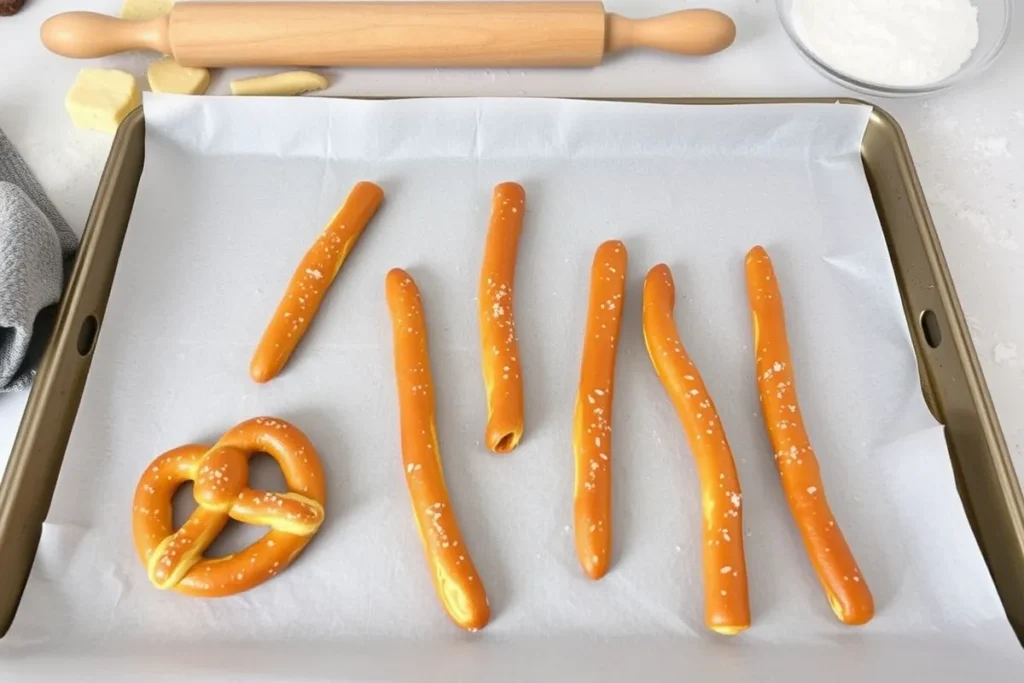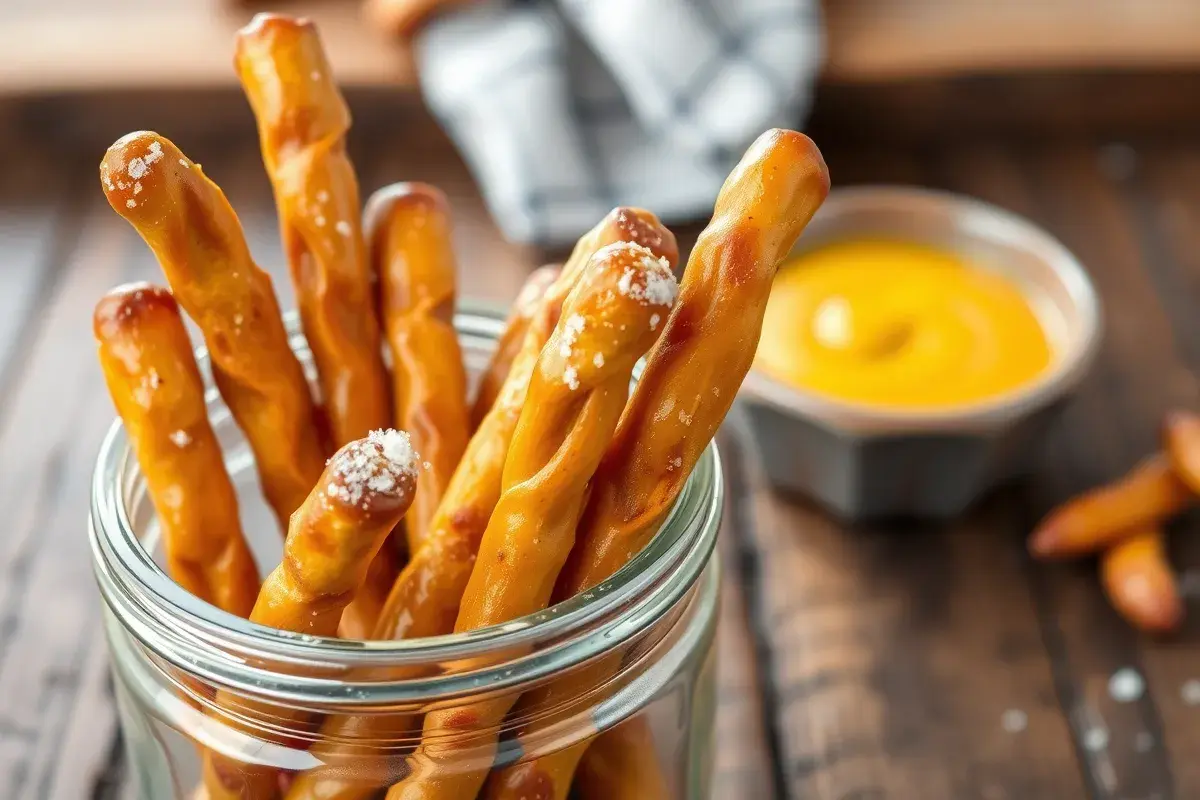Short, crunchy rods of dough with a salty exterior have captured the hearts of snack lovers around the globe. Pretzel sticks—often called pretzel rods—offer a delightful crunch and a light, savory flavor. They originate from traditional pretzel dough, which gets twisted or rolled into various shapes. Many people appreciate these snacks as a handy choice for parties, picnics, or afternoon munching. In this article, you will discover their history, different ways to create them at home, top-serving ideas, and tips for turning simple pretzel sticks into special treats.
Moreover, this guide covers the art of dipping sauces and topping suggestions. You will also learn about healthier ways to enjoy these crunchy rods, plus some fun ideas for entertaining guests. Keep reading to find out why these baked snacks remain a popular choice for many families.
1. The History of Pretzel Sticks
Pretzel sticks trace their roots to the broader pretzel tradition in Europe. Historians often connect pretzels to monasteries in early medieval times. Monks created small pieces of leftover dough and shaped them into loops or twisted forms. Over time, bakers found new ways to shape and bake pretzel dough, leading to the slender rods we know as pretzel sticks today.
1.1. The Evolution of Pretzel Sticks
However, the exact timeline is not always clear. Some sources suggest that shapes resembling arms crossed in prayer led to the distinctive twist. Others point to regional styles that inspired variations in shape and form. Yet, one fact stands out: these dough twists and rods became prized for their salty taste and durable texture.
1.2. Pretzel Sticks in the United States
In addition, German immigrants contributed significantly to the popularity of pretzels in the United States. Pennsylvania, in particular, became a hub for commercial pretzel baking. Eventually, manufacturers introduced the stick form to cater to snackers seeking convenient shapes that would fit easily into packages and lunch boxes.
1.3. Modern Day Pretzel Sticks
Today, pretzel sticks stand side by side with other savory snacks, from potato chips to crackers. Many households keep a bag of these crispy rods in their pantries for a quick fix. Furthermore, online retailers and stores carry a wide variety of flavors. Some offer cheese-infused rods, others carry honey mustard varieties, and several produce gluten-free options.
Despite the expansion of pretzel innovation, the unpretentious pretzel sticks remain a crowd favorite. Their long, slender form makes them perfect for dipping in sauces or pairing with cheeses. Consequently, they have become a must-have in party bowls and snack trays.
2. What Makes Pretzel Sticks Unique?
There are many reasons why pretzel sticks stand out among other salty snacks. First, their crisp exterior is baked to a golden hue. That gives them a visually appealing surface. Second, the salt crystals sprinkled on top contrast beautifully with the mellow dough inside. Therefore, every bite provides both texture and taste.
2.1. Practical Benefits of Pretzel Sticks
Furthermore, this snack’s shape has practical benefits. Unlike twisted pretzels, the straight rods are easy to hold. This makes them a great vehicle for scooping up dips. They also fit neatly into jars or tall containers, which means they can be stored without much fuss.
2.2. The Versatility of Pretzel Sticks
Pretzel sticks typically have a longer shelf life than soft pretzels. Consequently, people can buy them in bulk and keep them ready for spur-of-the-moment guests or impromptu snacking. This convenience, paired with a pleasant flavor, has secured their place in snack culture.
Yet, pretzel sticks also present plenty of ways to get creative. You can break them into smaller bits for toppings, coat them with sweet or savory additions. You can dip them in chocolate or peanut butter. In short, the rods serve as a canvas for endless possibilities.
2.3. Culinary Applications of Pretzel Sticks
Moreover, they play well with various cuisines. Pair them with guacamole for a Southwestern flair. Match them with hummus for a Mediterranean feel. Or dip them in nut spreads for a sweet-and-salty treat. In other words, you can adapt them to different taste preferences.
3. Choosing the Right Ingredients
Before tackling a recipe for homemade pretzel sticks, gather quality ingredients. Good results come from fresh flour, active yeast, and a pinch of salt. In addition, warm water helps activate the yeast. Some cooks like to add butter, while others prefer oil. Both choices bring richness to the dough.
3.1. Essential Ingredients for Pretzel Sticks
- Flour: Many recipes use all-purpose flour. However, bread flour can add chewiness.
- Yeast: Active dry yeast or instant yeast both work. Make sure the yeast is not expired.
- Salt: Use fine salt inside the dough for even blending. Then pick coarse salt for topping.
- Liquid: Warm water is common. Some people add milk for extra softness.
- Fats: Butter or oil can both soften the dough. Choose your favorite option.
Moreover, some recipes call for a small amount of sugar or honey. This addition helps feed the yeast. It also adds mild sweetness. Nonetheless, you can skip sweeteners if you prefer an extra-salty snack.
3.2. The Baking Soda Bath for Pretzel Sticks
Remember that a pretzel sticks recipe often relies on a baking soda bath. This step mimics the traditional lye solution in authentic German pretzel-making. Baking soda interacts with the dough, changing its surface texture. That leads to the characteristic pretzel-like crust and taste. Yet, use caution with water temperature and baking soda amounts. Too much can lead to a bitter aftertaste.
When shopping for ingredients, look for reputable brands. In addition, pay attention to expiration dates. Fresh components help produce the best possible snack.
4. Simple Homemade Pretzel Sticks Recipe

If you want a hands-on experience, try making pretzel sticks in your own kitchen. This recipe offers a straightforward method to get that signature crunchy result. The total time may vary, but most people can finish in about two hours, including dough rising time.
4.1. Ingredients for Homemade Pretzel Sticks
- 4 cups of all-purpose flour (plus extra for dusting)
- 1 tablespoon of active dry yeast
- 1 tablespoon of sugar (or honey)
- 2 teaspoons of fine salt
- 1 ½ cups of warm water (about 110°F)
- 2 tablespoons of melted butter or vegetable oil (optional)
- 8 cups of water (for the baking soda bath)
- ½ cup of baking soda
- Coarse salt for sprinkling
4.2. Equipment Needed for Pretzel Sticks
- Large mixing bowl
- Wooden spoon or dough hook
- Damp towel or plastic wrap
- Baking sheet (lined with parchment paper)
- Pot for boiling water and baking soda
4.3. Instructions for Making Pretzel Sticks
- Activate the yeast
- Pour the warm water into a mixing bowl.
- Stir in sugar and yeast.
- Wait about five minutes until it forms a frothy layer on top.
- Mix the dough
- Add flour, fine salt, and melted butter or oil to the yeast mixture.
- Use a wooden spoon or a dough hook to combine everything.
- If the dough feels too sticky, add flour in small increments.
- Knead and let it rise
- Knead by hand or use a stand mixer for about five minutes.
- Form the dough into a ball.
- Place it back in the bowl.
- Cover with a damp towel or plastic wrap.
- Let it rest in a warm area for about an hour or until it doubles in size.
- Shape the sticks
- After rising, punch down the dough to remove air.
- Transfer it onto a lightly floured surface.
- Cut the dough into even pieces (about 20-24 segments).
- Roll each piece into a rope, about a pencil’s thickness and 6-8 inches long.
- Prepare the baking soda bath
- In a pot, bring 8 cups of water to a light boil.
- Stir in the baking soda carefully.
- Reduce the heat to a simmer.
- Dip and arrange
- Gently place each dough rope into the simmering solution for 20-30 seconds.
- Remove it with a slotted spoon.
- Place it on the lined baking sheet.
- Top and bake
- Sprinkle coarse salt on the sticks.
- Bake in a preheated oven at 400°F (200°C) for 10-12 minutes.
- When they turn golden brown, take them out.
- Cool and serve
- Let the rods cool on a rack.
- Serve them warm or at room temperature.
In addition, you can sprinkle other flavors. Try garlic powder, onion powder, or dried herbs. For a sweeter version, roll them in cinnamon sugar right after baking. They make a delightful dessert snack.
5. Toppings and Seasonings for Pretzel Sticks
A simple sprinkle of salt is classic. However, you can switch up the flavor by using different toppings. Some popular ideas include:
- Everything Bagel Seasoning: Adds a blend of sesame seeds, garlic, onion, and poppy seeds.
- Cheddar Cheese Powder: Produces a tangy, cheesy crust on your pretzel sticks.
- Garlic-Parmesan Mix: Combine garlic powder and grated Parmesan cheese for a savory twist.
- Cinnamon-Sugar: Sprinkled after baking, it gives a sweet layer that children love.
For more variety, you can brush the baked rods with melted butter. Then coat them in herbs like rosemary or thyme. That approach also adds a pleasing aroma.
Moreover, feel free to test specialty salts. Sea salt, pink Himalayan salt, or smoked salt each bring a distinct edge to your pretzel sticks. Some adventurous snackers even use chili flakes or paprika for a spicy kick.
6. Fun Serving Ideas for Pretzel Sticks

Pretzel sticks are not just for munching alone. They can become a key feature in parties, get-togethers, and even special holiday feasts. Below are some fun ways to serve them:
6.1. Creative Ways to Serve Pretzel Sticks
- Dipping Station
Create a buffet of dipping options, such as mustard, cheese sauce, salsa, guacamole, or chocolate ganache. Label each dip so guests can pick their favorites. - Charcuterie Boards
Layer them alongside cured meats, cheeses, olives, and fresh fruit. The crunchy rods add texture to the platter. - Dessert Bar
Dip pretzel sticks halfway in melted chocolate. Top them with sprinkles, nuts, or shredded coconut. Let them cool on parchment paper before arranging them on a tray. - Candy Coating
Coat them with caramel or toffee for a sweet-salty mix. Wrap them in cellophane bags as party favors.
In addition, you can display them in tall glasses for a visually appealing snack table. Their shape looks neat, and guests can grab one quickly.
7. Healthier Alternatives for Pretzel Sticks
While traditional pretzel sticks may have a fair amount of refined flour and sodium, there are ways to make them more nutritious. Some bakers use whole wheat flour or spelt flour to boost fiber content. Others replace part of the salt in the dough with salt substitutes or herbs.
7.1. Making Healthier Pretzel Sticks
Furthermore, you can skip extra butter or oil in the dough. This will reduce fat while still keeping a pleasant texture. However, be mindful of dryness, as fat helps maintain a softer crumb. You can compensate by adding a small spoon of yogurt or applesauce if you want a lighter profile.
7.2. Gluten-Free Options for Pretzel Sticks
For a gluten-free version, experiment with gluten-free flour blends. Many brands now offer mixes designed for bread-making. You might need a binding agent like xanthan gum, depending on the blend. The taste might differ slightly from regular pretzels, yet you can still achieve a crunchy snack.
Additionally, watch your toppings. Go easy on salt if you need to limit sodium. Instead, opt for a light sprinkle of sesame seeds or a dash of herbs. These changes can turn pretzel sticks into a more balanced snack choice.
8. Common Mistakes to Avoid When Making Pretzel Sticks
Many home bakers run into small hiccups when making pretzel sticks. Here are a few tips to keep in mind:
- Overproofing the Dough
Leaving the dough for too long can make it collapse. Monitor it closely and shape once it doubles in size. - Skipping the Baking Soda Bath
Some might think this step is optional. However, it is crucial for that pretzel-like crust. - Using Old Yeast
Expired yeast leads to dough that barely rises, resulting in dense sticks. - Too Much Flour
Adding too much flour can make the dough stiff. For better results, add flour gradually. - Excessive Baking Time
Overbaking can dry out pretzel sticks. Watch them closely and remove them when they turn golden.
Moreover, keep track of your oven’s accuracy. Some ovens run hotter or cooler than their settings. A thermometer can help you confirm the real temperature inside.
9. Cultural Significance and Traditions of Pretzel Sticks
Although pretzel sticks emerged as an offshoot of twisted pretzels, they still reflect centuries of cultural development. In Germany, pretzels represent luck and spiritual blessings. Families often serve them during festivals or religious holidays. In the United States, the Pennsylvania Dutch community popularized a wide array of pretzel products.
9.1. Pretzel Sticks in Different Settings
In addition, pretzels—especially the crunchy types—play a part in sports events. Stadiums and arenas sell them as quick snacks to keep fans satisfied during games. Some breweries offer them as bar bites to complement their beer selections.
9.2. Pretzel Sticks in Holidays
During the holiday season, people in certain regions might hang pretzels on Christmas trees as edible ornaments. Children sometimes receive large pretzels as gifts, symbolizing good fortune. While sticks are less common for hanging, they still maintain the same spirited history.
Furthermore, pretzel sticks have found their way into food trends. Chefs sometimes crumble them to form crusts for fish or chicken. They may top casseroles and bakes to add crunch. Consequently, these slender rods have transcended the boundaries of casual snacking and entered the realm of culinary creativity.
10. FAQs
Below are detailed answers to some common questions. These are questions that many readers have asked about pretzel sticks.
10.1. Are Pretzel Sticks a Healthy Snack?
They can fit into a balanced diet because they are typically low in fat. However, they can be high in sodium. If you watch your salt intake, look for low-sodium versions or bake your own at home. In addition, pair them with protein-rich dips like hummus or peanut butter to make them more filling.
10.2. What are Pretzel Sticks Made Of?
They start with a simple dough of flour, water, salt, and yeast. Some recipes also add sugar or honey. After shaping, many bakers give them a quick dip in a baking soda bath before baking. This method helps create the signature taste and texture.
10.3. What Should I Dip My Pretzel Sticks In?
Many people prefer classic yellow mustard. Yet, you can try cheese sauce, ranch dressing, salsa, guacamole, or even chocolate. For sweet dips, melted caramel or a mix of powdered sugar and cream cheese works well. The choice depends on whether you want something salty, tangy, or sweet.
10.4. Why is Auntie Anne’s Pretzel Sticks so Good?
Auntie Anne’s uses a special dough that includes a hint of sweetness. They also bake fresh pretzels throughout the day, so customers enjoy them while they are warm and soft. Additionally, the balance of salt crystals on top makes them flavorful. The brand’s focus on freshness and consistent quality contributes to their reputation.

